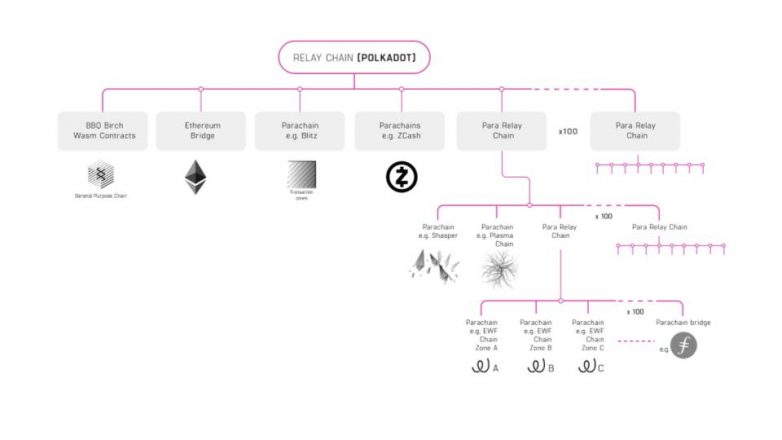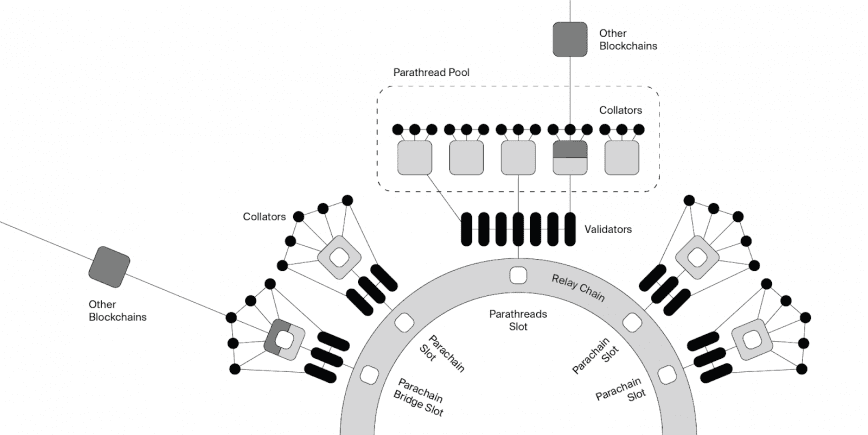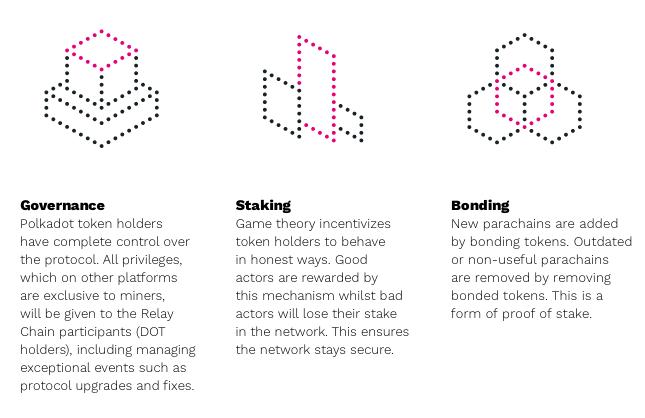What Is Polkadot? Introduction to DOT
Polkadot is a blockchain protocol designed to support individual chains or "parachains."

Key Takeaways
- Polkadot is a blockchain protocol designed to support "parachains created by different developers.
- It aims to provide interoperability, scalability, and security.
- DOT trading began in August 2020.
Share this article
Polkadot is a blockchain protocol designed to support multiple chains within a single network. It aims to overcome a problem in the current blockchain landscape: hundreds of blockchains exist in isolation and have little ability to communicate.
History of Polkadot
Polkadot is developed by Parity Technologies, led by Gavin Wood and Jutta Steiner, two former Ethereum executives. The project is also supported by the Web3 Foundation, a closely related organization that provides the project with funding, advocacy, research, and collaborations.
Parity was founded in 2015. Initially, it began to work on node software for Ethereum, called the Parity Ethereum client. The company has phased out support for that project, leaving it to focus on Polkadot and a related project, Substrate.
Development began in November 2017, when developers published the first code on Github.
The company launched two proof-of-concepts in mid-2018 and deployed Polkadot’s first parachain in July 2018. Polkadot launched in an “initial” state in May 2020, and token transfers were enabled in August 2020.
As of September 2020, Polkadot’s relay chain has not yet been activated, and chain auctions are not yet live.
What Is Polkadot?
As noted above, Polkadot’s design is meant to support several chains. It is not merely a single blockchain that exists in isolation. There are several advantages to its approach:
- Scalability: Polkadot supports multiple blockchains through a mechanism called “sharding” or parachains. This allows transactions to be processed efficiently and in parallel.
- Interoperability: Different Polkadot parachains and applications can share information and functionality thanks to the project’s interoperable design and compatibility between chains.
- Specialization: Each Polkadot parachain can be tailored to a specific use case or application.
- Forkless upgrades: Polkadot can be upgraded without time-consuming and divisive hard forks; new features can be added without overhauling the network entirely.
Substrate and Parachains

Each chain on Polkadot is called a “parachain.” Developers can create their own parachain with Substrate, a framework for building blockchains.
It is also possible to run blockchains developed with Substrate without being part of the Polkadot network; Polkadot merely provides interoperability, consensus, security, and other services for Substrate-based chains.
Parachains can support features found in many other blockchains, including smart contracts (Ethereum), ZK-snarks (Zcash), and UTXO transactions (Bitcoin). These features are not a fundamental part of Polkadot; instead, these features can be added to and removed from parachains.
Developers can also call functions that exist on other parachains.
There are many different use cases for Polkadot parachains, including transaction chains, oracle chains, identity chains, file storage chains, data curation chains, IoT chains, finance chains, and privacy chains.
Over 25 projects are building on Polkadot, including Chainlink and Ocean Protocol. A complete list of target projects is listed here.
Other Infrastructure

Parachains are just one of several components that make up the Polkadot Network. Other components include:
- The relay chain: The main communication hub between parachains and the “backbone” of Polkadot.
- Parachains: Independent blockchains that run on top of the relay chain, bonded and reserved by auction.
- Parathreads: A lighter alternative to parachains for developers that only want to try Polkadot, offered under a “pay-as-you-go” model.
- Bridges: Modules and contracts that connect to other blockchains such as Bitcoin and Ethereum.
Additionally, there are several actors in the Polkadot network that keep the blockchain operational:
- Validators, who stake DOT tokens, validate proofs from collators and participate in consensus.
- Nominators, who stake DOT tokens and secure the relay chain by selecting trustworthy validators.
- Collators, who collect transactions and create proofs for validators.
- Fishermen, who monitor the network and report malicious activity.
The DOT Token
Polkadot raised about $140 million by selling its DOT token in a 2017 ICO. The company also ran two private sales in 2019 and 2020 and raised an estimated $100 million in those later sales.
Due to a bug in the Parity’s Ethereum wallet, about half of the original ICO tokens were frozen. Those frozen tokens have not been recovered, but the loss has not affected Polkadot’s ability to operate.
Polkadot began to allow investors to trade the remaining tokens starting in August 2020. Since then, DOT has been listed on over 40 exchanges, and high trading volumes have caused the coin’s market cap to skyrocket and become a top-five coin.
The DOT token was also “redenominated” by a factor of 100x at the time that trading began. This did not change the token’s market cap; it merely made token amounts more readable.
There are three main uses for the DOT token apart from basic financial transactions: governance, staking, and bonding.
Facing the Competition
There are at least two blockchains that can be considered competitors. Cosmos, which went live in March 2020, aims to build a network of chains just like Polkadot. However, there are technical differences between each platform.
If Polkadot is correct, its approach provides a more cooperative, shared security model.
Ethereum 2.0 also has features that are comparable to those seen in Polkadot. Both blockchains rely on sharding, or different chains dedicated to specific purposes. Once again, there are some technical differences: Polkadot claims its approach offers better availability and validity, and that it can work with a lower number of validators per shard.
The project can also be compared to Tezos, which is also designed to support upgrades without hard forks; however, there are few other similarities between the two platforms.
Summary
Polkadot is a promising project. Given that many app developers are looking for ways to reach a wider audience, and given that there are many different blockchains, the platform could become useful to many.
The DOT token’s high-ranking market position may also be beneficial to the project’s reputation.
However, there are also some issues: Polkadot’s troubles with token management, combined with the fact that there are more established platforms, could limit the extent of the network’s adoption. Polkadot has not yet produced a “killer app,” and it remains to be seen whether it will enter the spotlight beyond its initial price-related hype.
Share this article

